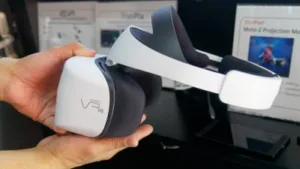Abenecel was at the 4YFN event and is based in Korea. The company is a technology licensing company that has a patented compression pre-processing system that can be used for graphics files and can also be used on office documents, pdfs and wbp files (web graphics) as well as video. We struggled to understand exactly what the company does, but we understand that it works a little like the Beamr pre-processing for video.
The company said that it used its techniques on an MP4 file of UltraHD that reduced from 1.67GB to 138MB – a reduction of 91.95% reduction.
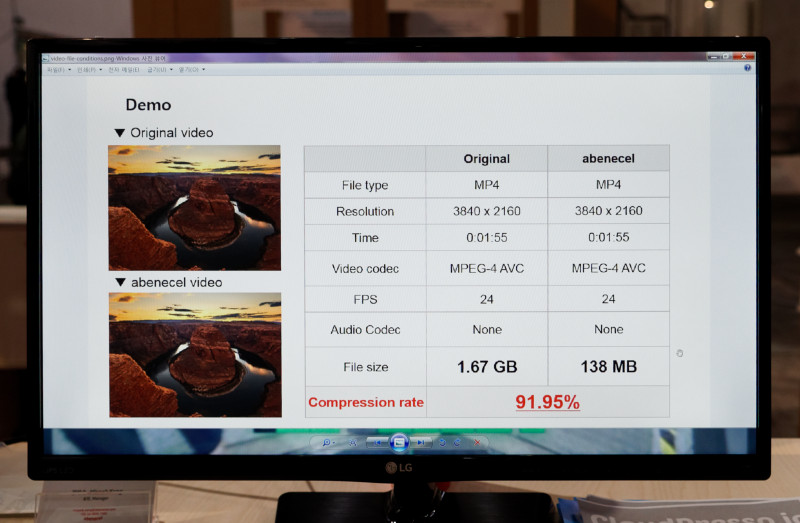 Abenecel has big claims for its CloudPresso io technology. Image:Meko
Abenecel has big claims for its CloudPresso io technology. Image:Meko
It can process documents with images and pre-process the images before they are subject to the usual compression techniques. It can also ‘re-organise data inside non-graphic files’. However, language was something of a challenge when it came to the technical aspects (and the company was being cautious not to reveal too much, I think). The company was looking for licensing partners and can supply an SDK. The company’s website seems to be just an enquiry form, when we checked!
ABox42, the STB supplier, was with its close collaborator, Zattoo, again and we briefly discussed the ebb and flow of interest in the Google TV platform compared to using Linux. At the moment, the company told us, it has some concerns over the longer term support for different versions of Android TV and as a result, some decisions to use it are being deferred. The company hopes these issues will be clarified soon so that it continue to roll out. Those that can’t defer are choosing Linux.
Analogix announced a ISB ‘re-timer’, effectively a signal conditioning chip, that is likely to be used by companies that want to support longer than usual connections from mobile phones to displays, for example from mobile devices to VR headsets. In fact over longer distances, you may need multiple re-timers.
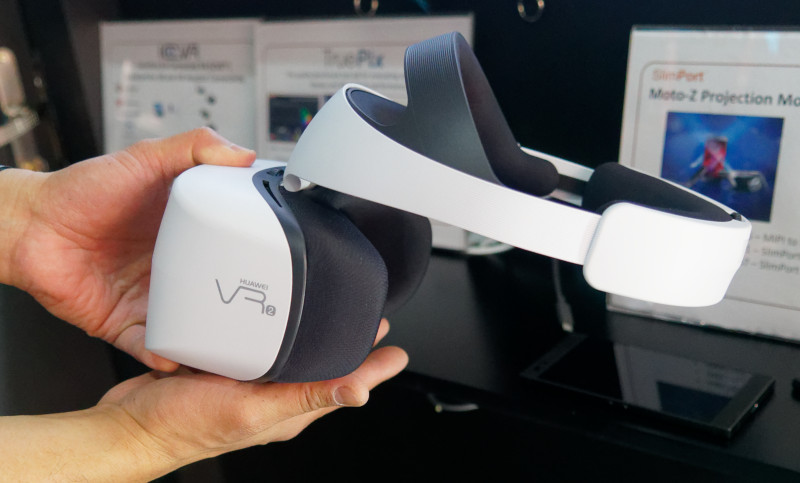 Huawei’s VR2 was shown by Analogix. It’s a headset that connects to a smartphone, but has its own displays. Image:Meko
Huawei’s VR2 was shown by Analogix. It’s a headset that connects to a smartphone, but has its own displays. Image:Meko
On the booth, the company was showing the Huawei VR2 headset, which is designed to connect to a mobile device. The company, along with LG, Dell and Tencent (for content) is a member of the ICVR group, which is working on developing wired VR headseat interface standards based around USB Type-C. We reported on this initiative last May, but it had slipped out of your reporter’s mind! (ICVR, LLC Established to Create Standard for VR Headset Connectivity). The aim is to establish a standardised way to communicate back data from the senors on the headset to the host device, using standard physical interfaces, to ensure interoperability.
There is a specification proposal in draft form and the group is sharing it with others for feedback with a hope that a V1.0 of the specification could be launched in Q2.
(In the past, Analogix has developed specifications and then offered them to VESA for standardisation and it doesn’t seem unlikely that this might happen in the ICVR case – Man. Ed.)
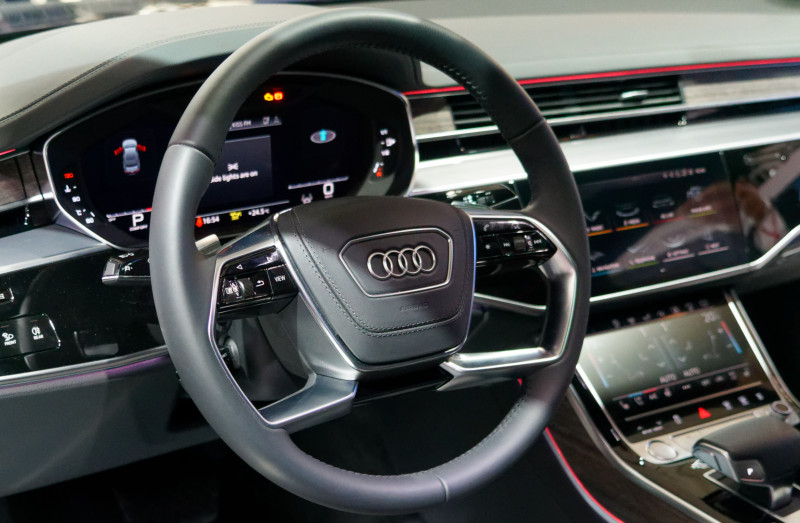 Audi was getting a lot of attention for this three display configuration. Image:Meko
Audi was getting a lot of attention for this three display configuration. Image:Meko
We reported on Beamr, which has pre-processing technology to optimise the performance of standard codecs, from IBC and the company was at MWC to explain its services to companies that are trying to use mobile technology for video. The company told us that it can stream good quality 1080P video at just 2 Mbps and that is a low enough rate that it becomes feasible to transmit FullHD over 4G, no problem.
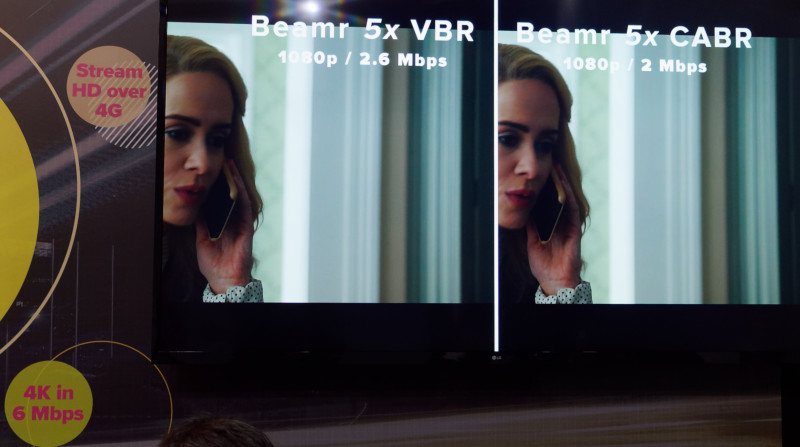 The company had a demo of video at 2.6 – 3.1Mbps and at 2Mbps and it was very hard to see any difference. Image:Meko
The company had a demo of video at 2.6 – 3.1Mbps and at 2Mbps and it was very hard to see any difference. Image:Meko
At the 4YFN show we stopped by BeepVIP which was showing a system for retail that puts clothing onto a video image of a consumer, so that they can see how the clothes would look. The image can be viewed on an LFD as a ‘virtual mirror’ or shown on the user’s mobile device. The system worked moderately well, although as it used a Kinect style scanner and the weather was cold, so people trying the system found the clothes superimposed on their heavy clothing – not a good look. “Everything is better naked” was the quote from the company’s staff on that topic!
The firm claims a key advantage, which is in the speed of scanning of clothing. The firm told us that the time needed to input a design into this kind of system was often very long, so the systems were not economical to use. BeepVIP claims to be able to scan an article of clothing in just five minutes, using the same scanner and this radically changes the economics. The company told us that the system is in use in retailers including Mango and El Corte Ingles, the Spanish department store.
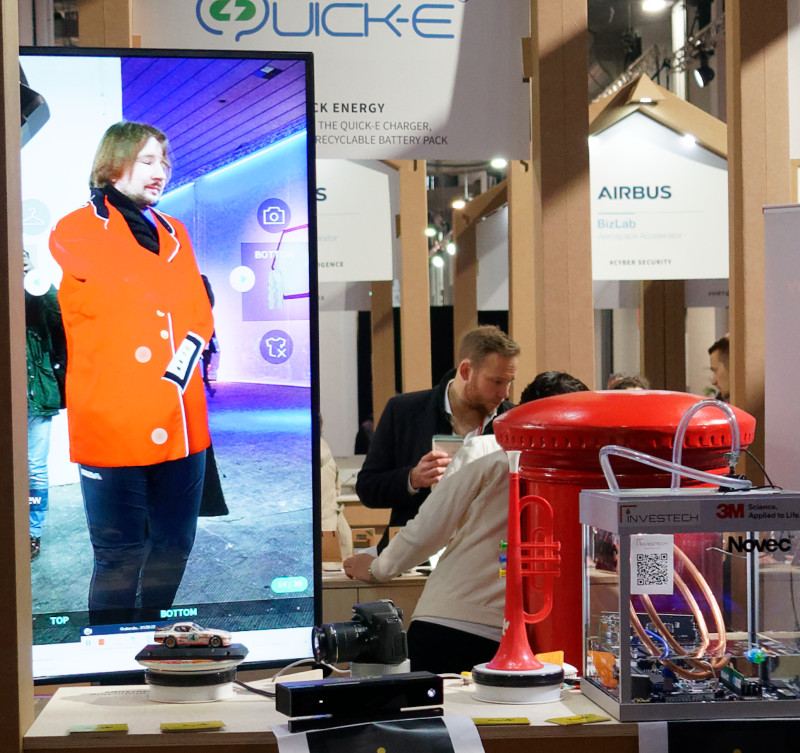 BeepVIP was showing this Virtual Mirror. Image:Meko
BeepVIP was showing this Virtual Mirror. Image:Meko
Biel Glasses are developing ‘Adapted reality’ systems for people with visual impairment – which means around 250 million people globally or 25.5 million in Europe. For example, the glasses can create an image that highlights barriers and, in the example shown in our photograph, highlighting steps. It has also developed a system that can move images from the centre of the eye towards the edges for people suffering from macular degeneration, which causes poor vision in the foveal region. There is a zoom function for helping with the reading of signs. It is also developing facial and object recognition technology to help individuals that have problems with recognition.
The company is making complete systems including camera, processor and glasses. It told us that it has also used the Zeiss Cinemizer headset. The processor is based on an Nvidia Jetson TX1 GPU.
 Biel Glasses enhances the view for those with poor eyesight. In this example, steps are highlighted. Image:Meko
Biel Glasses enhances the view for those with poor eyesight. In this example, steps are highlighted. Image:Meko
Cat was showing its new Cat S61 smartphone with laser distance measurement and special sensors for industrial use. The phone features an infrared camera that has been updated with a number of new features, enabled by FLIR, which was also at the show to highlight its technology:
- Increased temperature range up to around 400ºC (it can be used to measure temperatures with an accuracy of around ±5%).
- There’s a new feature that blends the temperature and visual image to help to highlight, for example, overheating components or areas
- Sharing of images on social media.
The S61 has a new laser distance measuring tool and also has an organic compounds sensor that can be used to measure, for example, air quality (and it didn’t think much of the air quality at Showstoppers, but the building is next to a busy road in the middle of the city, so that’s not surprising).
The S61 is a new phone that has a 5.2″ FullHD display with GorillaGlass 5. It’s a rugged phone with IP68 approval and is based on a Snapdragon 630. RAM is 4GB and storage is 64GB with microSD expansion. The main camera is a 16MP version and the second one is 8MP. The battery has 4,500 mAh capacity and the price is expected to be about €900.
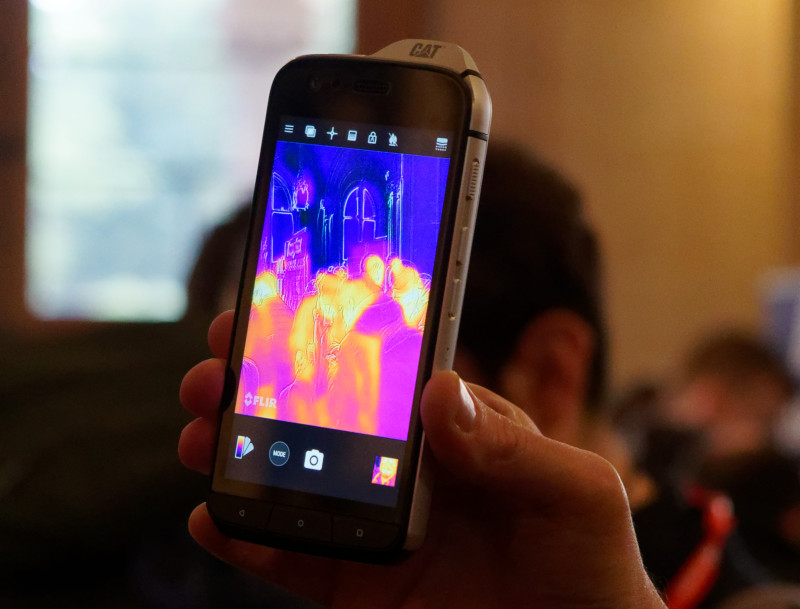 CAT’s S41 Smartphone supports FLIR for heat measurement. Image:Meko
CAT’s S41 Smartphone supports FLIR for heat measurement. Image:Meko
Crucialtec is a supplier of touch controllers and fingerprint detectors that was in Hall 1 and was showing some of its design wins. The company’s controllers are in the Microsoft ‘Modern Keyboard with touch panel’. The company is also in the Samsung Notebook 9, the Microsoft Surface, the Google Pixel XL and the Huawei Mate 10.
The company has developed an anti-spoofing fingerprint system that uses an integrated heart rate measurement system that ensures that the finger is ‘live’.
 Crucialtec has live fingerprint detection. Image:Meko
Crucialtec has live fingerprint detection. Image:Meko
Daimler was showing the new “A” class car which has an unusually wide display.
 The Daimler A Class has a very wide display that looks very ’21st century’. Image:Meko
The Daimler A Class has a very wide display that looks very ’21st century’. Image:Meko
Dolby Labs had a private meeting room outside the main halls in the ‘South Village’ (a tented area) and was talking to potential and existing clients, but did not have any demos.
Dynamics was at the Pepcom evening event and was showing its Wallet Card universal charge/credit card which includes a small display. The company said that it has taken some time to get banks to accept these universal cards, but a number of factors are increasing the popularity. In particular, customer service can be much better, with cards being instantly issued if there is a security issue. This can be much better if the user is an international traveller.
The cards can use E Ink displays, although some have reflective LCDs. The company uses some energy harvesting techniques to keep the cards ‘topped up’. The challenge is that the cards can only have 1/10oz (2.83 gms) of battery weight. Banks are typically supplying the cards free as it costs a lot to issue or re-issue a plastic card. Issuers that are now signed up include Visa, Mastercard, JCB, Sprint and five others. The buttons on the card toggle between different issuers.
 Dynamics’ Wallet Card supports mag strip, chip & pin or contactless payment. Image:Meko
Dynamics’ Wallet Card supports mag strip, chip & pin or contactless payment. Image:Meko
Like Goodix, Egis was showing its under-OLED fingerprint technology at the show (Vivo is reckoned to be the first brand to use the concept in a smartphones, but it uses optical technology from Synaptix). It also had facial recognition technology.
Ericsson had its usual very big area in Hall 2 and most of the emphasis was on 5G transmission and applications. We spotted a demonstration of VR and we spoke to an academic researcher from Stockholm that is working with Ericsson, who told us that it has been working on improved tiling algorithms to support 360º video. The concept is similar to that used by Fraunhofer and included in the HEVC-D, but a different scheme is used to transmit the tiles. (parts of the image are sent at high resolution, with most at low resolution). Gaze technology is used to check where the user is looking and the company said that its technique has very low latency and is fast to change the tiles. The demo was structured that with the technology in place, the bit rate of the stream was reduced by 85%. The research will be in an article in the March issue of IEEE VR and some information was released at the last Siggraph.
Flexenable of the UK was on the GB booth and was showing LCDs made using its flexible organic TFT substrates, and developed with Merck. The company told us that it doesn’t expect LCDs to be in really flexible applications, that are continuously being bent or rolled, but more often in conformable applications, where the bending is done during system manufacture, then left ‘as is’. e.g. automotive applications. Fully flexible displays are likely to be OLEDs.
The company highlighted, as we have previously reported, that the technology for deposition can be done at low temperatures, which means that TAC film can be used, rather than Polyimide. The processes are very similar to those used for existing A-si TFT creation, although there are fewer CVD processes and more spin coating.
The first mass production display is a 4.68″ LCD that is being developed under the deal between Flexenable and Truly Semiconductor, that was announced last July. Mass production of the new display is expected in mid-2018.

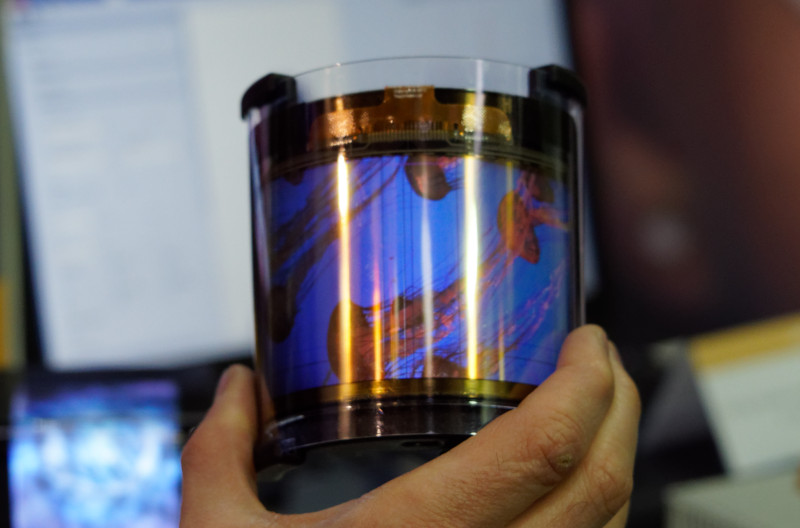 Flexenable was showing flexible LCDs. Image:Meko
Flexenable was showing flexible LCDs. Image:Meko
Fraunhofer HHI was showing its viewport dependent tiling scheme for optimising the streaming of VR content, with a mixture of high and low resolution tiles. The technology has now been standardised by MPEG as the Omnidirectional Media Format (OMAF).
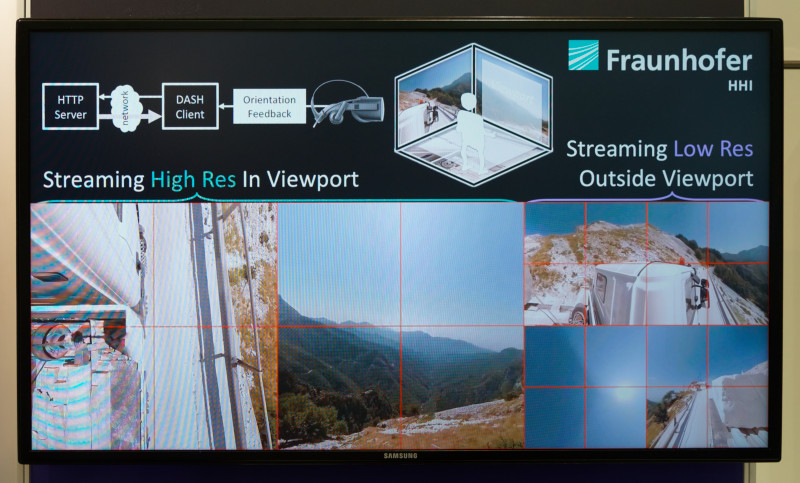 Fraunhofer’s tiling scheme is now standardised as OMAF. Image:Meko
Fraunhofer’s tiling scheme is now standardised as OMAF. Image:Meko
Gemini is a an Indigeogo project created by Planet Computers which is an up-to-date Android smartphone that is based on the industrial design of the popular Psion computer of the 1980s, with a hardware keyboard (and using the same designer!). The project raised nearly $2 million and the units are shipping now at $499 for the Wi-fi version, $599 for the mobile version. The display is a 5.99″ LCD.
 The Gemini smartphone is based on the form factor of the original Psion PDA. Image:Meko
The Gemini smartphone is based on the form factor of the original Psion PDA. Image:Meko
Green Optics of Taiwan was showing a couple of headsets. The first was a prototype Fortis VR headset for gaming and with 1280 x 720 resolution in the OLED displays. The headset runs on HDMI for the graphics and USB for the sensor data. The OLEDs are mounted above the eyes and the optical system is prism-based.
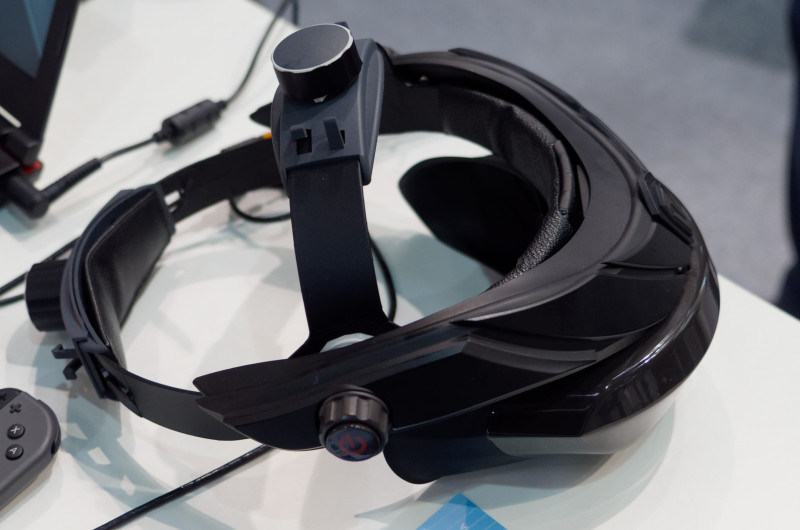 The Green Optics Fortis is for gaming. Image:Meko
The Green Optics Fortis is for gaming. Image:Meko
The second headset we looked at had the imager above the glasses and is designed for single eye operation in an AR mode (Vu:T 100). It is intended for a specific application – showing subtitles in cinemas etc. Many who would like to go to the cinema have hearing problems and the headset can help them without distracting others. It can also be used to support a wide range of different language subtitles. The image is offset to the bottom of the display so that it doesn’t block the main view. However, to accommodate the 20% of users that are left eye dominant (figure from Vuzix – Man. Ed.), the lens is designed to slide from side to side. The imager is again an OLED with 1024 x 192 of the display shown.
 Green Optics Vut100 is for single eye operation and can be moved to the left or right eye. Image:Meko
Green Optics Vut100 is for single eye operation and can be moved to the left or right eye. Image:Meko
Harman was showing technologies with partners but had a much smaller booth than when it was an independent company. One of the announcements at the show was that it is working with PTC to integrate the Harman Media Suite into the PTC Vuforia AR platform to allow the blending of video, audio and chat with CAD-based rendered objects. The main application is likely to be in professional applications.
HP was at the Pepcom evening event and was highlighting that it has two versions of its Envy X2 12.3″ FullHD ‘always connected’ PC, one based on the Qualcomm architecture, (HP Has Qualcomm-based 2-in-1) but also another that supports the 7th Gen Intel Core I5 processor. While the Qualcomm version can be used for up to 22 hours, the Intel one supports operation for 19 hours and is slightly heavier (although lighter than the Microsoft Surface). The system has no fan and can charge to 90% in 90 minutes. Both units have 4G LTE modems. The Intel-based version was one of the new products at CES.
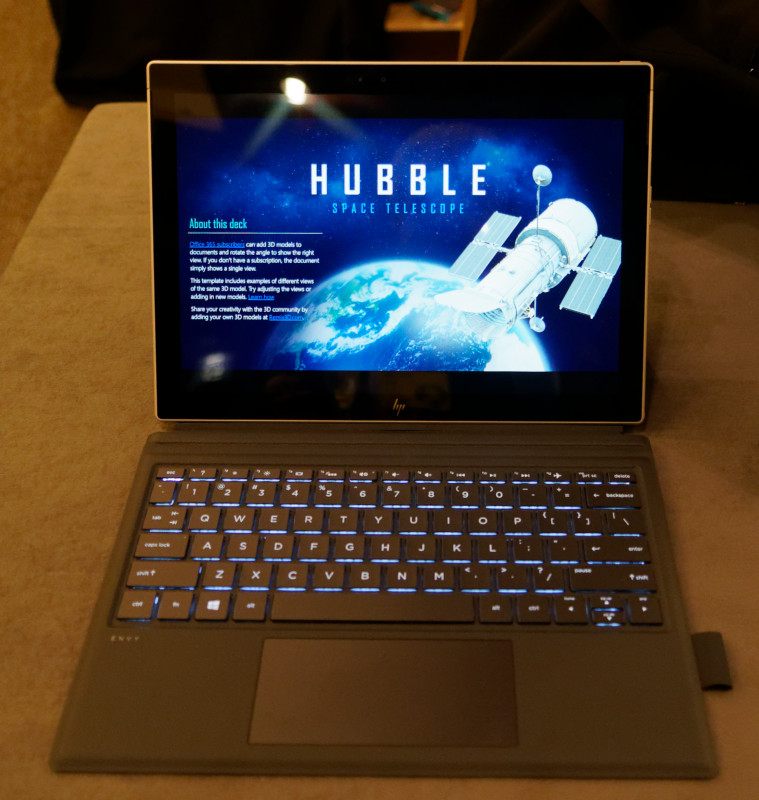
HP was also showing on its booth a self service system that it supplies for some corporates to allow corporate users to buy accessories and small peripherals such as mice, when there is no IT supply department on site or where 24 hour coverage is needed. The user can charge the cost to an internal cost code and receive immediate delivery. (We asked about ‘Elegy’ and found it is a dummy brand!)
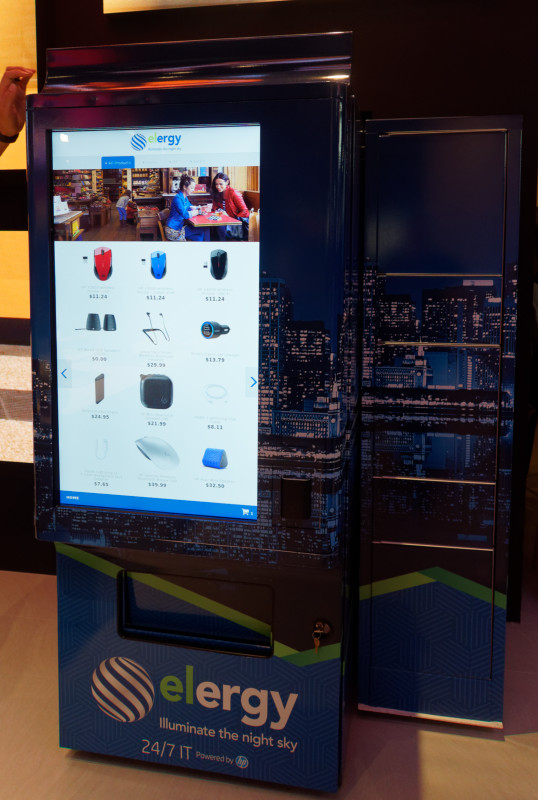 HP is already installing this 24/7 IT supply department in some corporate offices. Image:Meko
HP is already installing this 24/7 IT supply department in some corporate offices. Image:Meko
InfinityAR was showing a headset made by JorJin of Taiwan that uses the company’s SLAM technology which can use a stereotracking camera to create data to maintain the user’s position in a room, without the need for infrared scanners. When used with an IMU, the system can support full 6DOF operation using the firm’s own algorithm. The company has plug-ins for 3D engines such as Unity and can offere automatic AR scene setting.
Check www.infinityar.com
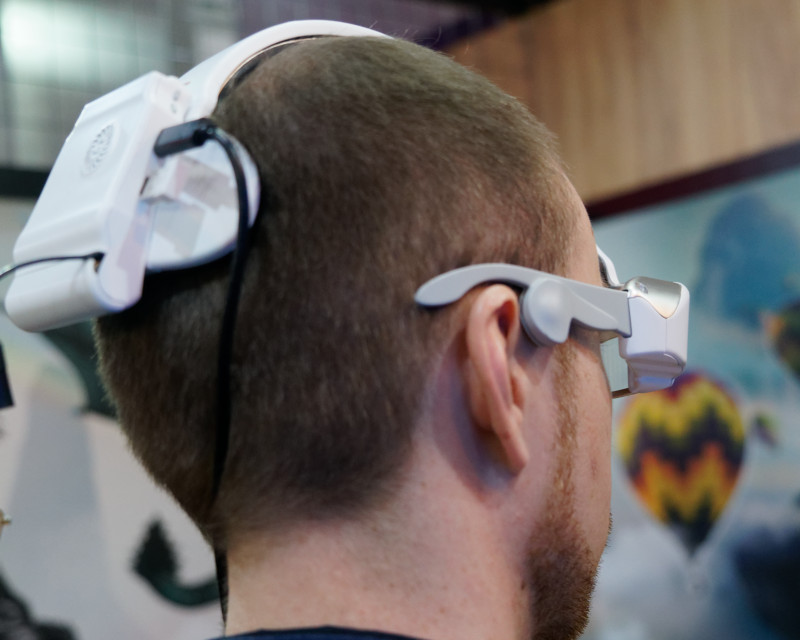 InfinityAR was using a headset from JorJin. Image:Meko
InfinityAR was using a headset from JorJin. Image:Meko
As we reported from CES, Intel is heavily promoting 5G technology and was showing a range of applications including 5G-based VR and drones and also had a new and prototype 5G-equipped convertible PC. The PC had large vertical and horizontal antennas that were being used to also support the unit in landscape and portrait mode.
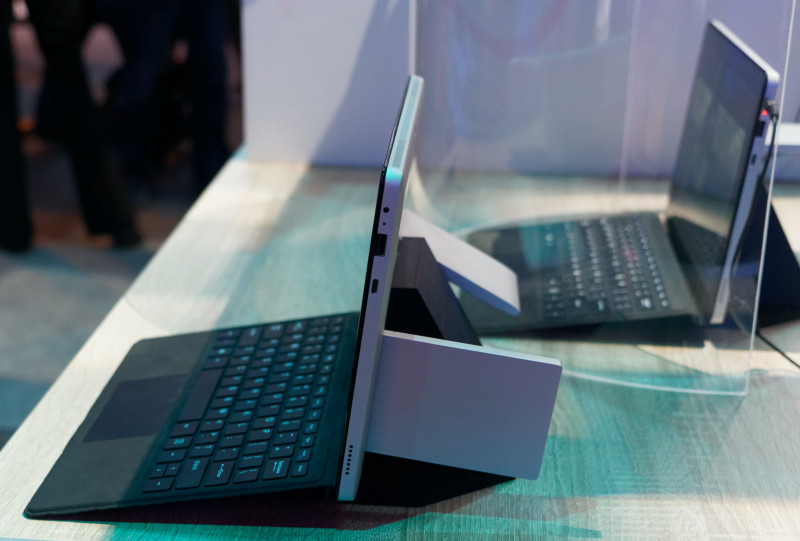 This Intel 5G Convertible prototype has dual antennas. Image:Meko
This Intel 5G Convertible prototype has dual antennas. Image:Meko
Intel also showed a ‘Citybeacon’ concept public kiosk which can be used to provide information and services to communities. Features of the unit include
- Displays for information distribution
- A terminal with touch for interactive use.
- Speakers and lighting
- Air quality and UV level analysis
- Wi-Fi and iBeacon as well as payment technologies for paying for local services such as parking.
CityBeacon is based in the Netherlands and has offices in Belgium and Menlo Park, California.
![]() The CityBeacon at Intel. Image:Meko
The CityBeacon at Intel. Image:Meko
Like Qualcomm, Intel was demonstrating 802.11ax Wi-Fi. It also talked a lot about the work it had done at the Olympic Winter Games and we covered this in another article (PyeongChang Olympics Showcase Next Generation Broadcasting Options (Part 1))
iStaging was showing its technology for creating 360º panoramas using a smartphone, a special lens and a motorised tripod head. The company is aiming the product at professional applications such as real estate agents, so is selling the technology as a service at $29 per month for 15 ‘rooms’ which can be viewed on its cloud service.
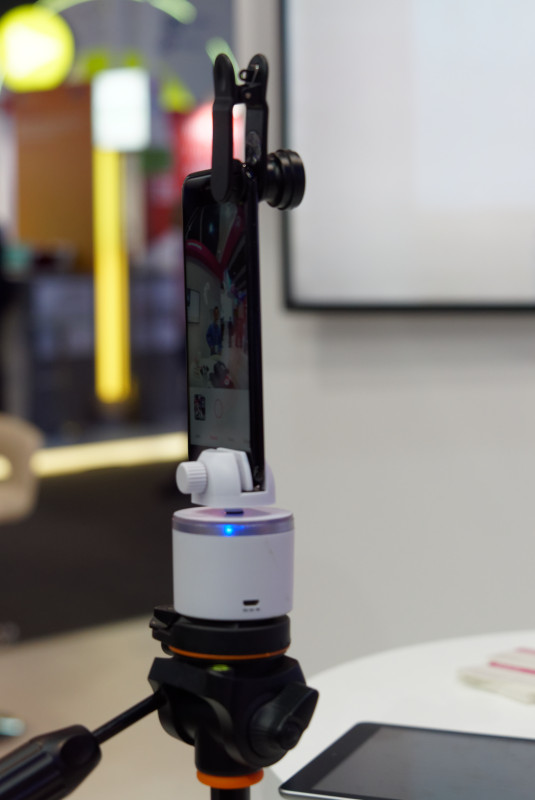 The iStaging system for 360 degree capture uses a motorised tripod head. Image:Meko
The iStaging system for 360 degree capture uses a motorised tripod head. Image:Meko
MWC was the first chance we had to catch up with JorJin which is a maker of AR headsets from Taiwan. There were two versions on display and the company has others. The firm typically uses LCoS and the company had a stereo 3D headset, the J-reality which uses 0.37″ LCOS imagers with 1280 x 720 resolution and producing more than 4,000 cd/m² of output and using Lumus waveguides to support a 40º FOV. The platform is fully integrated and uses a Snapdragon 820 with 3GB of RAM and 32GB of storage. The headset will probably go on sale around June/July and will cost more than $3,000.
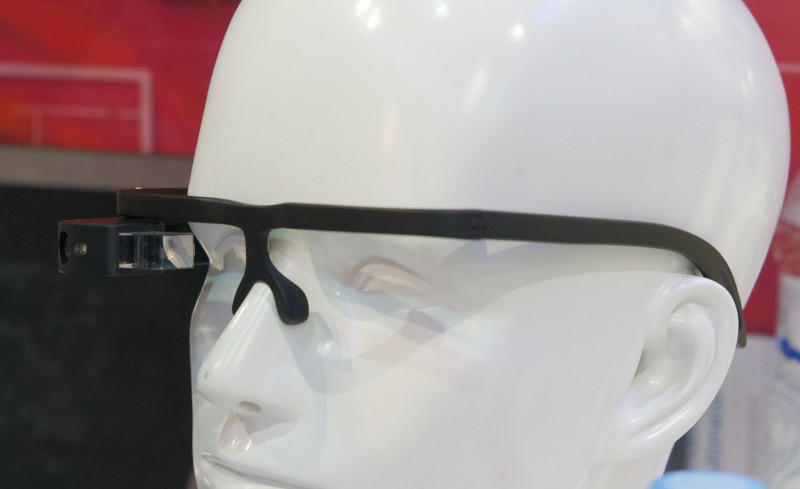 Jorjin has a low res single AR display. Image:Meko
Jorjin has a low res single AR display. Image:Meko
 JorJin is working with InfinityAR, which was also at the show, for SLAM without the need for infrared scanners. Image:Meko
JorJin is working with InfinityAR, which was also at the show, for SLAM without the need for infrared scanners. Image:Meko
The company also has an Android 5.1-based (TI Omap 4460/1GB/16GB) 800 x 480 single eye AR system based on an LCOS imager, the J-100. The company sees applications in professional AR such as service and logistics, but also promotes it for applications such as sports including cycling.
Korea Telecom was showing an automotive infotainment system called Giga Drive. The company is working with Sound Hound to support voice operation. The company told us that it has been working with thirteen companies around the world over fourteen years on the technology. It was also showing a multi-player VR game that was being run over 5G. Oh, and a ‘drone taxi’. It was shown at CES a couple of years ago, but is now getting ready for launch. It needs 100Mbps of connectivity to work.
 KT has been working on automotive infotainment for 14 years. Image:Meko
KT has been working on automotive infotainment for 14 years. Image:Meko
Logicom was showing its Volt-R smartphone which integrates a pico-projector based on a laser/mems engine (not DLP) with 1280 x 720 resolution and 31 Lumens of output. The company claims 5,000:1 contrast and the 4,000mAh battery is said to last for up to four hours. The smartphone is just 153 x 75.6 x 10.28mm in size and weighs 205g. It includes a 5.5″ FullHD LCD with 2.5G glass.
The handset is based on a Mediatek MT6750V/WT and Mali T860 with 3GB of RAM and 32GB of ROM. The rear camera has a 21mp sensor and the front one 13mp. It supports Android 7, Nougat and costs $600. It is available now, initially on Amazon.fr at the Amazon.fr/logicom shop.
(31 lumens is weak, but this handset looks absolutely acceptable in other terms, so the test will be whether end users are happy to pay the price for the projection function. BR)
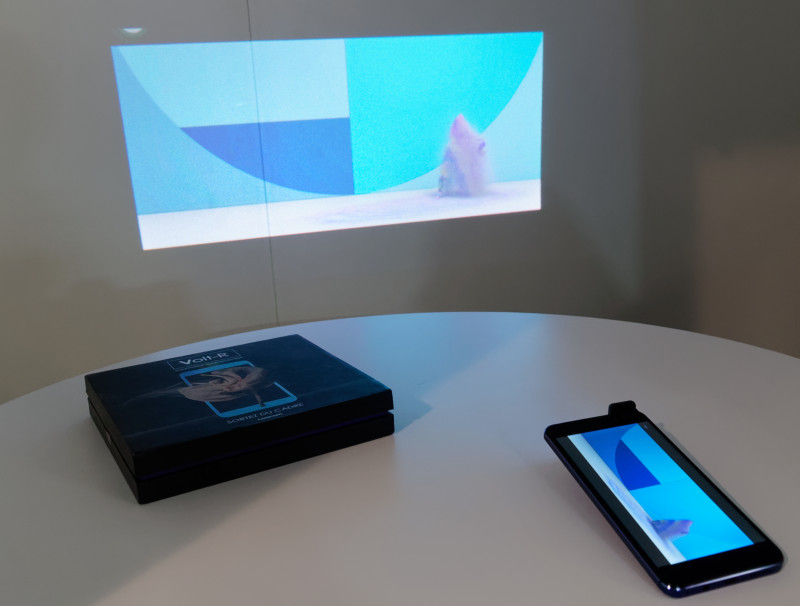 Logicom’s smartphone has a pico projector. Image:Meko
Logicom’s smartphone has a pico projector. Image:Meko

